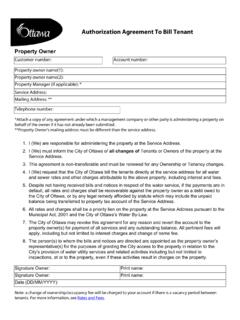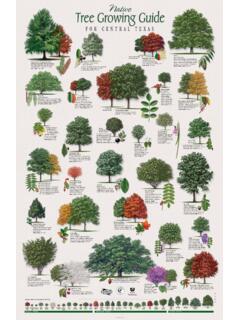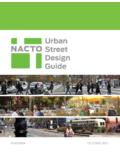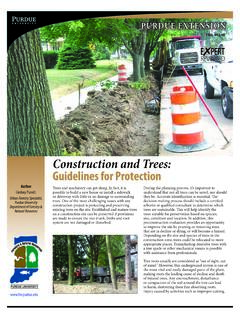Transcription of Urban Design Guidelines for Gas Stations
1 Urban Design Guidelines for Gas Stations May 2006. Compte tenu de la nature de ce document, il n'est disponible qu'en anglais. La Ville pourra, sur demande, traduire ce document au complet ou en partie. Les demandes de traduction doivent tre pr sent es la Division des services en fran ais par t l phone au 580-2424, poste 21536). Due to its technical nature, this document is available in English only. The City of Ottawa may translate this document or parts thereof on request. Requests for translation should be forwarded to the French Language Services Division or 580-2424, ext. 21536). A gas station is a facility where gasoline or other fuels are sold and where maintenance and minor automobile repair services may be conducted. A gas station consists of a gas bar with gasoline outlets and typically other associated facilities such as car washes, automotive services, convenience stores and food services.
2 Purpose and Application The purpose of these Guidelines is to provide Urban Design guidance at the planning application stage in order to assess, promote and achieve appropriate development of gas Stations . Specific site context and conditions will be reviewed in conjunction with these Guidelines . These Guidelines are to be applied throughout the city for all gas station development. When gas Stations are located in areas identified as Mainstreets, the Guidelines for Mainstreets also apply. When gas Stations are located together with drive-through facilities, the Guidelines for drive- through facilities also apply. Where a Community Design Plan or relevant planning study exists, these Guidelines will augment those documents. They will also be used to help inform the preparation of new Community Design Plans. Objectives To promote compatible gas station development that improves its existing or planned context.
3 To protect and enhance the character and quality of the districts and neighbourhoods where gas Stations are located;. To enhance the public streets and contribute to a high quality public space;. To create safe and controlled traffic circulation that balances the needs of vehicles and pedestrians; and To minimize impacts on adjacent land uses that could be caused by on-site activities. City of Ottawa Planning and Growth Management Department Page 1. Urban Design Guidelines for Gas Stations May 2006. Official Plan and By-law Direction The Official Plan identifies compatibility as a key Design objective for the built environment over the next 20 years. As per sections and of the Official Plan, achieving compatibility of new development, such as gas Stations , will involve not only considerations of built form, but also of operational characteristics and the development context. Annex 1 of the Official Plan identifies the protected rights-of-way sufficient to provide enough area for the streetscape elements and meet the needs of pedestrians and cyclists.
4 Annex 3 of the Official Plan contains a number of Design considerations that provide suggestions for how to meet the Design Objectives and Principles in section of the Official Plan. All other policies of the Official Plan and applicable regulations, such as the Private Approach By- law, the Signs By-law and the Zoning By-law must be met. Context and Challenges Numerous trends in the industry are affecting the Design of gas station sites. Gas Stations often operate 24 hours and tend to locate on larger sites, and contain an increased number of gas pumps. Auto services associated with gas Stations are shrinking, while other services such as convenience stores, car washes, banking machines, retail units and drive-through services are increasing, which results in getting consumers out of their vehicles and circulating around the site on foot. Additionally, major petroleum companies have adopted a set of standard building and canopy types to assert a cohesive image and presence in the marketplace.
5 As a result of these trends, the Design of gas station sites presents several challenges, including incorporating prototypical building designs and corporate image elements into the immediate context; addressing the complexity of large sites and the requirements of the many different uses;. designing a circulation pattern to meet the needs of both vehicles and pedestrians; supporting a pedestrian-friendly environment along public streets; and using landscape areas effectively to improve the overall environmental and visual quality of the area. Other Available Guidelines Urban Design Guidelines for Large-Format Retail (2006);. Urban Design Guidelines for Development along Traditional Mainstreets (2006);. Urban Design Guidelines for Development along Arterial Mainstreets (2006);. Urban Design Guidelines for Drive-Through Facilities (2006);. Urban Design Guidelines for Outdoor Patios (2006);. Infill Housing Design Guidelines - Low-Medium Density (2005) and Regional Road Corridor Design Guidelines (2000).
6 Urban Design Guidelines The Urban Design Guidelines for gas Stations are organized into the following six sections: 1. Streetscape and Built Form 2. Pedestrians and Cyclists 3. Vehicles and Parking 4. Landscape and Environment 5. Signs 6. Servicing and Utilities City of Ottawa Planning and Growth Management Department Page 2. Urban Design Guidelines for Gas Stations May 2006. 1. Streetscape and Built Form Guideline 1: Respond to the positive elements of the context through such means as building height, setbacks, building orientation and architectural styles (Figure 1). Figure 1: The architectural treatment of this gas station canopy reflects the context. Guideline 2: Locate building structures (such as car washes, convenience stores, and canopies). close to the street to help define the street edge (Figures 2 and 3). Figure 2: A convenience store close to the street contributes to a well-defined street edge.
7 Figure 3: The canopy Design creates an interesting streetscape in a commercial context. City of Ottawa Planning and Growth Management Department Page 3. Urban Design Guidelines for Gas Stations May 2006. Guideline 3: Provide ample landscaping, in combination with building orientation, to enhance the streetscape and define the street edge when setting building structures back from the street is unavoidable (Figure 4). Figure 4: Ample landscaping in the front yard enhances the streetscape while still allowing for views into the site. Guideline 4: Design all sides of buildings and pump islands with a consistent architectural style to enhance the streetscape (Figure 5). Figure 5: The detail of this gas station building contributes to an interesting and visually pleasing streetscape. Guideline 5: Provide transparent windows and doors for retail buildings to ensure visibility between the store, the pump islands and surrounding streets.
8 City of Ottawa Planning and Growth Management Department Page 4. Urban Design Guidelines for Gas Stations May 2006. Guideline 6: Use clear windows for the car wash fa ades facing public streets. They animate the street by providing views into the car wash and act as poster cases for advertising (Figure 6). Figure 6: The glass windows of this car wash face the public areas. 2. Pedestrians and Cyclists Guideline 7: Provide an unobstructed metre wide pedestrian walkway between the public sidewalk (and/or parking areas) and building entrances (Figures 7 and 8). Figure 7: The pedestrian walkway makes the site easily accessible for pedestrians. Figure 8: On this site, pedestrian walkways link different components on the site. City of Ottawa Planning and Growth Management Department Page 5. Urban Design Guidelines for Gas Stations May 2006. Guideline 8: Provide an unobstructed metre wide sidewalk in the public right-of-way across private access driveways.
9 Ensure little or no change in elevation (Figure 9). Figure 9: The public sidewalk across the private driveway provides a pedestrian zone. Guideline 9: Distinguish walkways from driving surfaces by using varied paving treatments and by raising walkways to curb level. Guideline 10: Locate required bicycle parking close to the building entrance in a manner that does not impede pedestrian movement (Figure 10). Figure 10: The bicycle parking is located close to the store entrance. City of Ottawa Planning and Growth Management Department Page 6. Urban Design Guidelines for Gas Stations May 2006. 3. Vehicles and Parking Guideline 11: Locate vehicular access points to the site as far away as possible from street intersections. Guideline 12: Minimize the number and width of driveways from the public street while ensuring that they meet the requirements of the Private Approach By-law. Avoid conflicts with pedestrians along the street by defining a narrower car entrance while allowing for tanker truck turning (Figure 11).
10 Figure 11: The car entrance and pedestrian crossing are clearly defined; flush contrasting paving allows for tanker truck turning. Guideline 13: Locate stacking lanes away from adjacent sensitive uses, such as residential and outdoor amenity areas, to reduce the impacts of noise and pollution that could be caused by stacking cars on such uses. Use landscaping and fencing to help buffer potential impacts. Guideline 14: Locate access points for stacking lanes away from public streets and driveways so that queued vehicles do not block the traffic along public streets or the movement of other vehicles on site (Figure 12). Figure 12: The start point of car wash stacking is located away from the public streets and other on-site traffic. City of Ottawa Planning and Growth Management Department Page 7. Urban Design Guidelines for Gas Stations May 2006. Guideline 15: Provide escape lanes and the appropriate number of queuing spaces as required by the Zoning By-law to create efficient stacking lanes and to minimize on-site conflicts (Figure 13).









